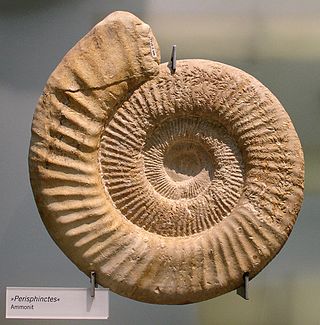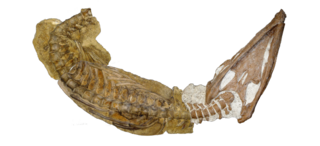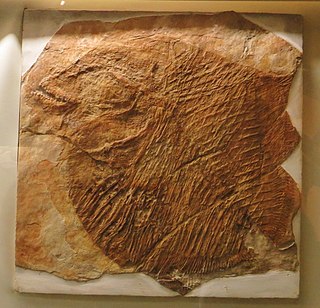
Sunnyodon is a genus of tiny, extinct mammal, probably of the Lower Cretaceous. Found in what is now southern England and Denmark, it was a relatively early member of the extinct order of Multituberculata. It is part of the suborder Plagiaulacida and family Paulchoffatiidae.

Scaphites is a genus of heteromorph ammonites belonging to the Scaphitidae family. They were a widespread genus that thrived during the Late Cretaceous period.
In the geological timescale, the Berriasian is an age/stage of the Early/Lower Cretaceous. It is the oldest subdivision in the entire Cretaceous. It has been taken to span the time between 145.0 ± 4.0 Ma and 139.8 ± 3.0 Ma. The Berriasian succeeds the Tithonian and precedes the Valanginian.

Aspidorhynchus is an extinct genus of predatory ray-finned fish from the Middle Jurassic to the earliest Cretaceous. Fossils have been found in Europe, Antarctica and the Caribbean.

Perisphinctes is an extinct genus of ammonite cephalopod. They lived during the Middle to Late Jurassic epochs and serve as an index fossil for that time period. The species P. boweni was named after the English chemist and geologist E. J. Bowen (1898–1980).

Aspidoceras is an extinct ammonoid cephalopod genus belonging to the family Aspidoceratidae.
Uhligites is an oppeliid ammonite included in the subfamily Streblitinae that lived during the latest part of the Jurassic and earliest Cretaceous; from about 150 to 140 m.y.a.

Brachauchenius is an extinct genus of pliosaurs that lived during the Late Cretaceous in what are now North America and North Africa. Only one species is known, B. lucasi, initially described by Samuel Wendell Williston in 1903 from a partial fossil skeleton discovered in a quarry in Kansas, United States. Many other fossil specimens attributed to the species were subsequently discovered, including an individual from Morocco whose presence was made official in 2016. Many contemporary pliosaur specimens were formerly attributed to Brachauchenius, but have since been reidentified as belonging to other genera or are recognized as indeterminate.

Ammonitina comprises a diverse suborder of ammonite cephalopods that lived during the Jurassic and Cretaceous periods of the Mesozoic Era. They are excellent index fossils, and it is often possible to link the rock layer in which they are found to specific geological time periods.

Hibolithes is a genus of belemnite that lived from the Middle Jurassic to the Early Cretaceous, and has been found in Antarctica, Greenland, Iran, Europe, South America, and New Zealand. In 2020, this genus was found in the Pedawan Formation in Sarawak, on the island of Borneo (Malaysia).

Hoploscaphites is an extinct ammonite genus from the Upper Cretaceous and the Lower Paleocene, included in the family Scaphitidae.

Coelodus is an extinct genus of marine and possibly freshwater pycnodont fish. It contains only one definitive species, C. saturnusHeckel, 1854, from the Late Cretaceous of Slovenia. Other species from the Late Jurassic to the Eocene have also been attributed to this genus based on isolated dental elements, but their assignment to Coelodus is uncertain, and this genus likely represents a non-monophyletic wastebasket taxon. A potential diagnostic trait is a prearticular tooth row with three regular highly elongated teeth.
Lusitanisuchus is an extinct genus of mesoeucrocodylian crocodyliform. Mostly fragmentary fossils have been found from several localities in Portugal and are Late Jurassic and Early Cretaceous in age.
Paramacellodus is an extinct genus of scincomorph lizards from the Early Cretaceous of England and France, and the Late Jurassic of Portugal and the western United States. The type species, Paramacellodus oweni, was named in 1967 from the earliest Cretaceous (Berriasian) Purbeck Group in Dorset, England. Additional material referable to a species of Paramacellodus, possibly P. oweni, has been described from the Morrison Formation, specifically in Como Bluff, Wyoming, and Dinosaur National Monument, Utah. An indeterminate species is known from the Berriasian aged Angeac-Charente bonebed in France. Paramacellodus belongs to an extinct family of scincomorphs called Paramacellodidae, which spanned most of Laurasia during the Late Jurassic and Early Cretaceous and represented one of the earliest evolutionary radiations of lizards.
Parviraptor is a genus of squamate containing one species, Parviraptor estesi, from the Late Jurassic (Tithonian) or Early Cretaceous (Berriasian) Purbeck Limestone Formation of Dorset, England. A second species, Parviraptor gilmorei, was described from the Late Jurassic Morrison Formation of Western North America; it was present in stratigraphic zone 4. However, the second species was subsequently transferred to a separate genus Diablophis. An indeterminate species is known from the Bathonian aged Kirtlington Mammal Bed.

Albalophosaurus is a genus of marginocephalian ornithischian dinosaur that lived in Japan during the Early Cretaceous. The type species is Albalophosaurus yamaguchiorum.
The Baños del Flaco Formation is a Late Jurassic to Early Cretaceous (Tithonian to Berriasian geologic formation in central Chile. The formation comprises limestones and sandstones deposited in a shallow marine to fluvial environment. Fossil ornithopod tracks have been reported from the formation.

Craspedites is an ammonoid cephalopod included in the Perisphinctoidea that lived during the Late Jurassic and Early Cretaceous, found in Canada, Greenland, Poland, and the Russian Federation.
Berriasella jacobi is an extinct species of ammonite from the late Jurassic and early Cretaceous. Because of its unique stratigraphic position, it is used as an index fossil to determine the boundary of the Cretaceous and Jurassic periods. The Berriasella jacobi zone defines the substage of the Lower Berriasian, the Berriasian being the lowest stage of the Cretaceous. However, due to the species limited geographic distribution, several other candidates that have been nominated, including Calpionella alpina.
Tirnovella is an extinct subgenus of ammonoid cephalopod, from the early Cretaceous.












